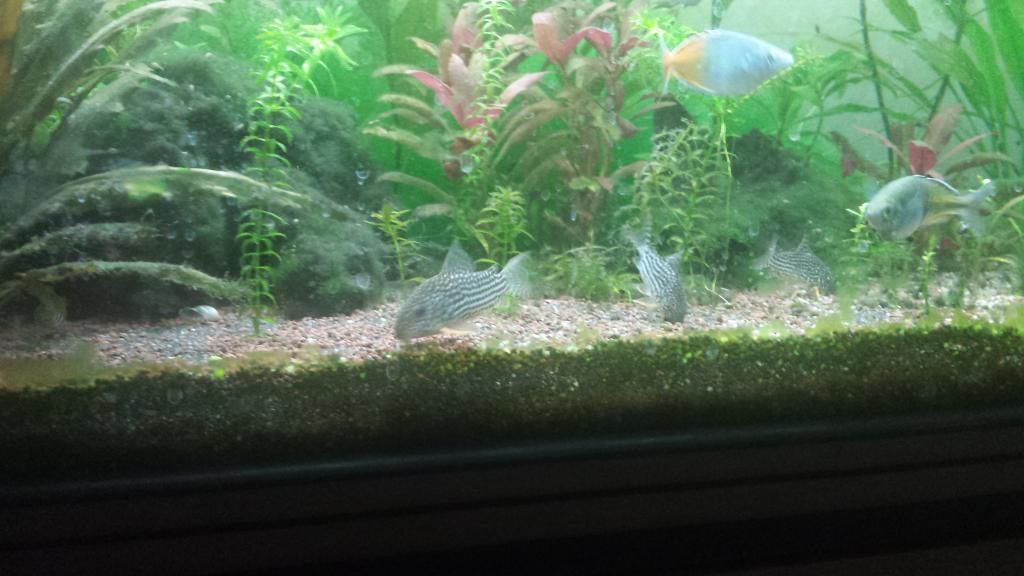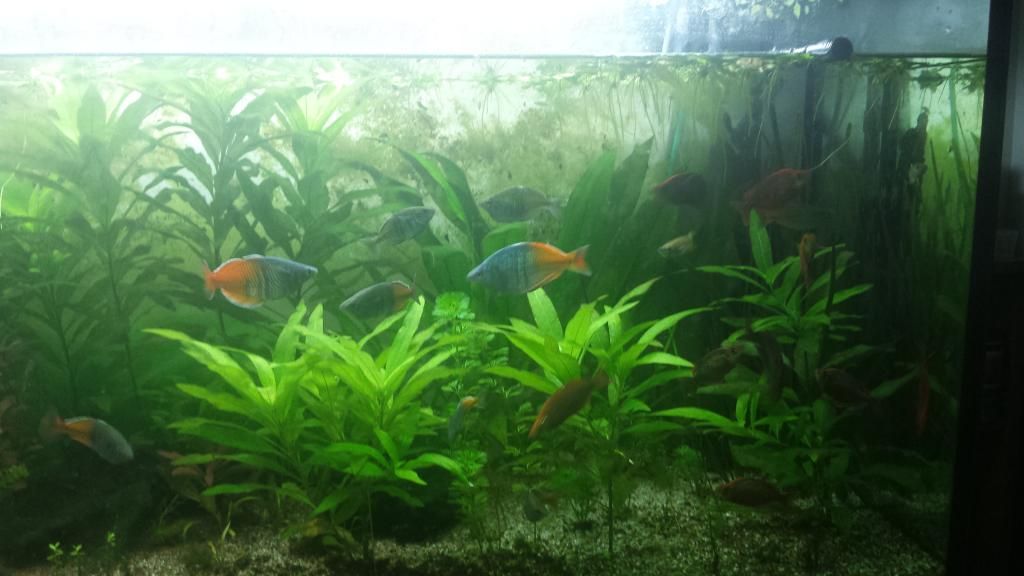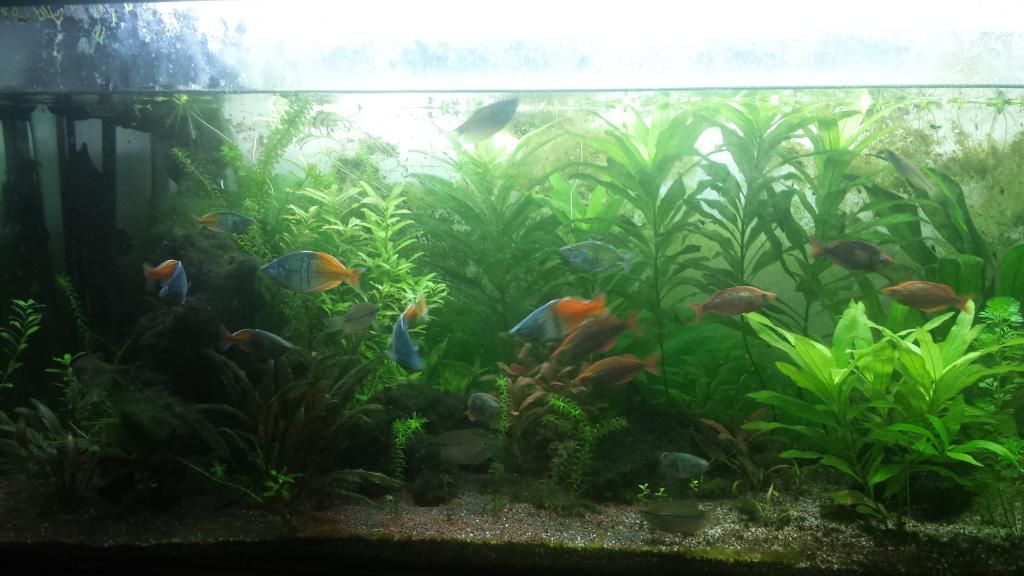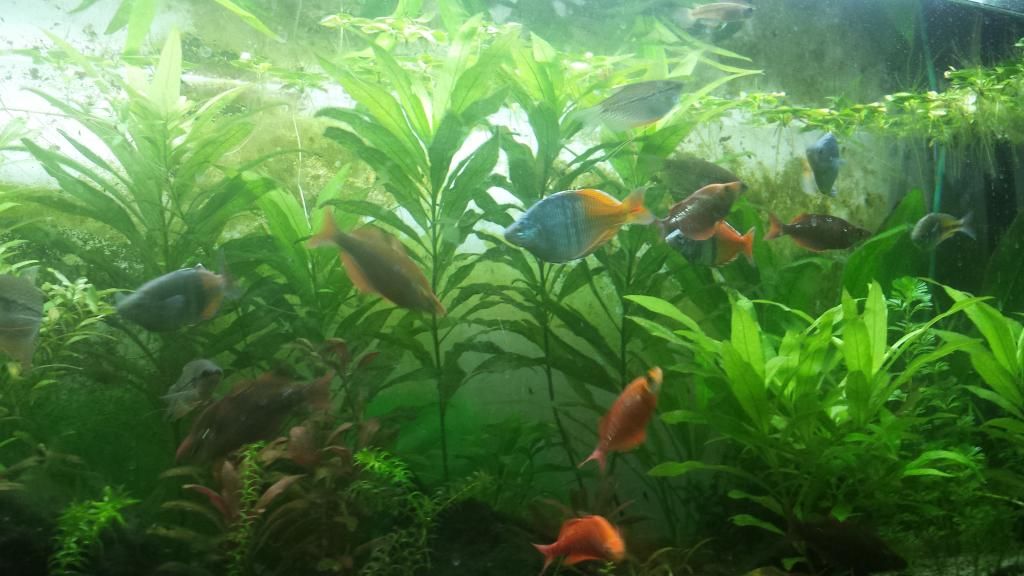You are using an out of date browser. It may not display this or other websites correctly.
You should upgrade or use an alternative browser.
You should upgrade or use an alternative browser.
Your current Fish tank Setups!
- Thread starter Malt_Vinegar
- Start date
More options
Thread starter's postsMy Corydoras have had babies. I spotted around 3-4 of them on Friday night. Hopefully they will survive and I'll transfer them to another tank when they are big enough.
cool. I've seen my sterbai's lay eggs sometimes, and I've seen my emerald catfish (technically not corys apparently) courting but not actually seen them laying I don't think. the boesemani too, and the celebes when I had them
however eggs dont last very long in my tank...I wanted to keep numbers stable and didn't like the idea of fry being eaten (even though its pretty natural) so stuck to egg-layers/scatterers (except my gourami but they won't build a nest to breed unless I induce the right conditions)
cool. I've seen my sterbai's lay eggs sometimes, and I've seen my emerald catfish (technically not corys apparently) courting but not actually seen them laying I don't think. the boesemani too, and the celebes when I had them
however eggs dont last very long in my tank...I wanted to keep numbers stable and didn't like the idea of fry being eaten (even though its pretty natural) so stuck to egg-layers/scatterers (except my gourami but they won't build a nest to breed unless I induce the right conditions)
I've always got eggs in my tank but this is the first time I've seen any fry. Like I said, once they are bigger enough, I've move them to another tank.
gh and kh are unrelated to the cycle if that is what you are asking. otherwise I wouldn't worry about their levels, on the high side but that can be good as it'll keep the water buffered so ph won't start to drop. my water reads harder than that iirc.
but as I say with such a small tank and for a betta you might want to consider using reverse osmosis mixed with regular tap to keep a consistently lower ph
Not sure why I wasted the money buying the kits then if its not needed?
How do I go about getting RO water? I never even heard of it until now...always had people just using tap water and aquasafe....its hardly a marine tank or anything
Associate
- Joined
- 31 Oct 2014
- Posts
- 11
Pictures of my three planted community tanks, all with pressurised CO2 and EI ferts.
65L Guppies and Corys, there's about 35 guppies and 5 corys in this tank, not that you'd know to look at the picture.

180L Community Corner Tank

220L 4ft Community Tank

65L Guppies and Corys, there's about 35 guppies and 5 corys in this tank, not that you'd know to look at the picture.

180L Community Corner Tank

220L 4ft Community Tank

Soldato
- Joined
- 22 Feb 2014
- Posts
- 2,810
Not sure why I wasted the money buying the kits then if its not needed?
How do I go about getting RO water? I never even heard of it until now...always had people just using tap water and aquasafe....its hardly a marine tank or anything
You can normally buy it from your LFS but that works out expensive in the long run.
You can buy kits that make it for you, but that works out expensive in the short term.
1st way is easier, 2nd way is more of a faf because making RO water strips all of the minerals out of the water and you have to add them back in again (minus what you are actually trying to remove)
I personally wouldn't bother because the advice I was given is once you go RO it is extremely difficult to go back to tap water without causing serious problems for your fish.
I understand that it is a neccessary evil in order to have a healthy marine tank though (which is something I have neither the time or inclanation to start at this stage in my life)
Not sure why I wasted the money buying the kits then if its not needed?
How do I go about getting RO water? I never even heard of it until now...always had people just using tap water and aquasafe....its hardly a marine tank or anything
they'll sell RO water at the LFS, for that size tank I imagine it won't cost much. But if you find a place that has bettas on the local tap water then I wouldn't worry, and even if not, with good acclimation they'd probably be ok. I think the most important thing would be making sure when you do water changes that the water has reached its max/stable ph before doing the changes, as in a small tank like that it'd be easy for a large swing if you changed half the water at 7.6 when it goes up to 8.2, it'd be a sudden 0.3 drop which isn't huge but not ideal, and done repeatedly wouldn't be good for sensitive fish like betta (never had one myself)
the reason for the hardness tests is not so much to check what the level is (although if it is very high or very low that's worth knowing) but more to check it every so often to see that it isn't dropping - if the hardness drops, the buffer goes and then you might get a sudden ph drop. to be honest though I extremely rarely check gh and kh now, once I was happy they were staying consistent and I wasn't making any big changes to the filters or anything
Last edited:
Pictures of my three planted community tanks, all with pressurised CO2 and EI ferts.
65L Guppies and Corys, there's about 35 guppies and 5 corys in this tank, not that you'd know to look at the picture.

180L Community Corner Tank

220L 4ft Community Tank

nice - what do you use for plant growth?
Associate
- Joined
- 31 Oct 2014
- Posts
- 11
Thanks 
I use pressurised CO2 (2kg Fire Extinguisher + regulator) for the carbon source and for nutrients I use Aquarium Plant Foods dry powders and mix my own fertiliser based on a slightly modified version of their recommended recipe. (I add a bit more MgSO4, and some K2SO4). Macro and micro are dosed on alternate days.
One of the major factors though is water flow around the tank, which has to be spot on to avoid problem areas. Consequently I have around 1300LPH flow on the 65l tank and around 4000-4500LPH on the two larger tanks. (This is true flow rate, not the exaggerated numbers given in the specifications). Without good water flow to provide a constant supply of CO2 and nutrient rich water to the plant leaves they won't thrive, and algae will get a foothold.
Lighting is relatively low, around 1.5WPG, which makes it easier to balance the CO2 requirements compared with a high light setup.

I use pressurised CO2 (2kg Fire Extinguisher + regulator) for the carbon source and for nutrients I use Aquarium Plant Foods dry powders and mix my own fertiliser based on a slightly modified version of their recommended recipe. (I add a bit more MgSO4, and some K2SO4). Macro and micro are dosed on alternate days.
One of the major factors though is water flow around the tank, which has to be spot on to avoid problem areas. Consequently I have around 1300LPH flow on the 65l tank and around 4000-4500LPH on the two larger tanks. (This is true flow rate, not the exaggerated numbers given in the specifications). Without good water flow to provide a constant supply of CO2 and nutrient rich water to the plant leaves they won't thrive, and algae will get a foothold.
Lighting is relatively low, around 1.5WPG, which makes it easier to balance the CO2 requirements compared with a high light setup.
ok yeah you put some more effort into that than I do lol - your plants are more lush etc than mine. Got more time now so might experiement a bit but don't really want to get into C02 injection if I can avoid it (dose liquid carbon atm)
yesterday I went in the tank room and saw my new killifish spawning in the moss-like algae on the big log I have - didn't take them long I only put them in the main tank last week.
yesterday I went in the tank room and saw my new killifish spawning in the moss-like algae on the big log I have - didn't take them long I only put them in the main tank last week.
Soldato
- Joined
- 22 Feb 2014
- Posts
- 2,810
Thanks
One of the major factors though is water flow around the tank, which has to be spot on to avoid problem areas. Consequently I have around 1300LPH flow on the 65l tank and around 4000-4500LPH on the two larger tanks. (This is true flow rate, not the exaggerated numbers given in the specifications). Without good water flow to provide a constant supply of CO2 and nutrient rich water to the plant leaves they won't thrive, and algae will get a foothold.
What filter/pumps are you using to deliver that kind of flow rate ?
1300 lph seems VERY high for a 65L
I have always worked on this 4 x tank volume per hour theory. (although my 2 current filters probably only just cover that flow rate.
I have quite a lot of very very fine particles in my tank, the only solution I have found to lower them is to throw a spare internal filter full of filter floss into the tank.
I did run a Fluval FX6 for a bit but the noise was really annoying me and it had to go, that did a good job of polishing the water though.
Pictures of my three planted community tanks, all with pressurised CO2 and EI ferts.
65L Guppies and Corys, there's about 35 guppies and 5 corys in this tank, not that you'd know to look at the picture.

180L Community Corner Tank

220L 4ft Community Tank

I have to commend you on the level of clarity for each of your tanks. There isn't a trace of algae to be seen!
Last edited:
Associate
- Joined
- 31 Oct 2014
- Posts
- 11
ok yeah you put some more effort into that than I do lol - your plants are more lush etc than mine. Got more time now so might experiement a bit but don't really want to get into C02 injection if I can avoid it (dose liquid carbon atm)
yesterday I went in the tank room and saw my new killifish spawning in the moss-like algae on the big log I have - didn't take them long I only put them in the main tank last week.
Not as much work as you might think, once the initial setup is done it's pretty much just a case of tweaking the CO2 rate from time to time and changing empty cylinders once every 3-6 months (depending on tank size/injection rate).
Good job with the killifish, shows they like it in there

Associate
- Joined
- 31 Oct 2014
- Posts
- 11
What filter/pumps are you using to deliver that kind of flow rate ?
1300 lph seems VERY high for a 65L
I have always worked on this 4 x tank volume per hour theory. (although my 2 current filters probably only just cover that flow rate.
I have quite a lot of very very fine particles in my tank, the only solution I have found to lower them is to throw a spare internal filter full of filter floss into the tank.
I did run a Fluval FX6 for a bit but the noise was really annoying me and it had to go, that did a good job of polishing the water though.
Before I got into planted tanks, CO2 and algae control, I used to think much the same about water flow, however I've come to appreciate the difference 10-20 x turnover can make. I've found the most common reason for problems with leaf drop (especially lower down the stems) and patches of algae is due to insufficient flow of water to the affected area.
Regarding water particles in the water, I find that the corys (which I have in all my tanks) by virtue of rooting around in the sand, kick up any fine detritus, the water flow stops it from settling, and it ends up in the filter. As a consequence the sand is kept very clean and dirt particles in the water are very low in number.
The 'particles' you can see in the photos of my tanks are fine CO2 bubbles. They are far more apparent in photos than in real life though.
Because most biological filtration (removal of ammonia/nitrite etc.) happens in the tank rather than the filter in a healthy planted tank, my filters are mainly used for mechanical filtration only, consequently they only have a single medium sponge and bag of Purigen in each. I have twin externals on the two larger tanks though.
Edit: The 65L has an APS 1400EF canister (about 800LPH true flow) and a 500LPH power head
The two larger tanks each have 2 x APS 1400EF canister filters and 2 x 1400LPH power heads
Last edited:
Associate
- Joined
- 31 Oct 2014
- Posts
- 11
I have to commend you on the level of clarity for each of your tanks. There isn't a trace of algae to be seen!
Thanks very much

It took me a while to work out the causes and remedies for algae problems. I tried many approaches over the years, including limiting and/or trying to balance nutrients, as excess nutrients or ratios outside of some magic number were often cited as the cause.
But I've come to accept that the light is the main culprit for both algae and, counter intuitively, poor plant growth, if not balanced with sufficient CO2, nutrients, water circulation and regular large water changes to remove organic waste. Light drives the plant to grow, and in doing so increases its demands for CO2 and nutrients.
Excess nutrients don't cause algae, but a shortage can, by virtue of stunting the plant growth. Stunted plants decay, decay produces ammonia, algae will bloom anywhere there is an ammonia source.
Some people don't mind it, but I hate algae, as you've probably already guessed

Caporegime
- Joined
- 1 Dec 2010
- Posts
- 53,754
- Location
- Welling, London
Agree with all your points there. My lighting systems pretty strong and my plants seem to be suffering already.
I only have the standard Juwel filter and no C02 system. Plants not looking great and plenty of algae. That crappy long stuff that looks like your plants are wearing a syrup.
Over xmas, I'm gonna invest in a good Eheim canister filter, a quality c02 unit and move to 40% water changes.
I only have the standard Juwel filter and no C02 system. Plants not looking great and plenty of algae. That crappy long stuff that looks like your plants are wearing a syrup.
Over xmas, I'm gonna invest in a good Eheim canister filter, a quality c02 unit and move to 40% water changes.






